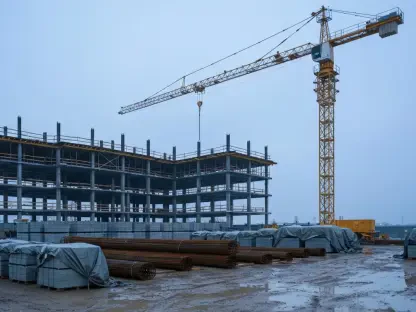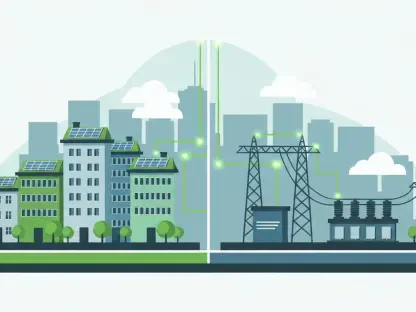Europe’s crane rental market has witnessed remarkable growth, with industry dynamics driven by evolving market demands and technological innovations over the years. As infrastructure projects leap forward and renewable energy initiatives expand, the crane rental sector has emerged as a critical component in the development landscape. The market, originally valued at USD 14.92 billion in previous years, is anticipated to reach USD 22.55 billion by 2027, showcasing an impressive compound annual growth rate (CAGR) of 4.70%. This surge is attributed to several pivotal factors, including the growing shift towards rental services and advancements in crane technology.
Factors Fueling Market Expansion
Construction and Infrastructure Developments
Europe is experiencing a construction boom, with massive infrastructure projects underway, fueling demand for crane rental services. High-rise structures, urban renewal initiatives, and developmental projects in cities like Berlin, Paris, and London are significant contributors. These developments require cranes capable of handling substantial loads, driving the shift from ownership to a rental model that offers flexibility and cost efficiency. Rental services provide construction firms access to state-of-the-art equipment without the financial burden of ownership, thereby optimizing operational expenditure. As demand surges, companies increasingly rely on rental providers to meet specific requirements of various projects, fostering collaboration and strategic partnerships in the industry.
Renewable Energy Revolution
The growing emphasis on sustainability has resulted in the rapid acceleration of renewable energy projects across Europe, notably in offshore wind farms and solar power installations. These projects demand specialized equipment that crane rental companies are uniquely positioned to provide. For instance, extensive offshore wind farms require large cranes for installation and maintenance tasks, thus boosting rental service demand. Technologically equipped cranes with precision features best meet these requirements, and rental companies adapt their offerings to meet market needs. As the continent continues embracing green energy solutions, the crane rental market enjoys growth spurred by these sustainable initiatives, reflecting a crucial aspect of the broader infrastructure transformation.
Technological Advancements and Market Trends
Integration of Smart Technologies
The integration of smart technologies is transforming crane operations, enhancing efficiency and safety. IoT and real-time analytics have revolutionized crane management, allowing for predictive maintenance and optimized logistics. Smart cranes equipped with advanced sensors offer detailed operational insights, reducing downtime and ensuring compliance with stringent safety standards. This technological evolution has positioned Europe at the forefront of industrial digitization, setting benchmarks in automated crane solutions. The incorporation of artificial intelligence further streamlines operations, enabling higher accuracy in complex maneuvers crucial for urban and industrial projects, thereby contributing to the sector’s growth trajectory and enhancing service quality.
Rise of Mobile and Fixed Cranes
The crane rental market has observed a significant rise in the adoption of mobile cranes due to their versatility and adaptability in varied environments. With urban areas becoming increasingly dense, mobile cranes’ ability to navigate tight spaces makes them indispensable, contributing approximately 62.8% of market share by 2027. In parallel, fixed cranes are gaining traction for large-scale industrial operations, particularly in offshore installations requiring permanent lifting solutions. These trends indicate a shift towards diversified crane utilization, catering to specific needs of different market segments. Continuous innovation in mobile and fixed crane technologies further bolsters this expansion, aligning with Europe’s overarching goals for infrastructure advancement.
Challenges and Constraints Facing the Industry
Operational Costs and Regulatory Framework
Despite the growth, the crane rental industry faces challenges, primarily high operational and maintenance costs that affect profit margins. Maintenance of cranes, adherence to safety inspections, and compliance with Europe’s stringent regulations pose financial constraints. The regulatory environment necessitates rigorous standards and continuous operator training, increasing operational expenses. Moreover, the fragmented landscape of compliance requirements across EU countries complicates cross-border operations for rental firms. Companies strive to navigate these regulatory hurdles by investing in training and certification programs to ensure expertise and safety, reflecting the sector’s commitment to maintaining high operational standards.
Skilled Workforce Shortage
The industry is handicapped by a shortage of skilled crane operators, critical for efficient operation and safety. As demand for advanced cranes increases, the need for trained personnel capable of handling sophisticated technologies becomes more acute. This workforce gap, coupled with stringent certification requirements, complicates recruitment for rental firms. To address this, companies are investing in training initiatives aimed at enhancing operator skills and ensuring compliance with evolving technical standards. Despite these efforts, the shortage persists, representing a significant constraint that needs proactive strategies to ensure the sector’s sustained growth and safety compliance, highlighting the imperative of a robust human resource approach.
Opportunities and Strategic Adaptations
Expansion Amidst Technological Evolution
The adoption of smart crane technologies presents a prime opportunity for market expansion. Leveraging IoT and AI innovations enables rental companies to refine operations, reduce costs, and improve service delivery. This technological shift aligns with Europe’s digital advancement objectives, reinforcing competitiveness. Furthermore, the surge in offshore wind installations necessitates specialized lifting solutions, creating lucrative prospects for rental firms tapping into this niche. Businesses aim to enhance competitive advantage by capitalizing on technology-driven efficiencies, augmenting service offerings, and optimizing equipment utilization, facilitated by strategic alliances and mergers in response to emerging market dynamics, depicting a landscape ripe for innovation-led growth.
Strategic Movements Among Industry Leaders
Leading players like Manitowoc, Liebherr, and Terex are reshaping market dynamics through strategic innovations. These companies focus on integrating advanced crane technologies while expanding geographically via acquisitions. Recent developments, such as Terex’s cloud-based management systems and Liebherr’s acquisition of a rental firm, illuminate industry shifts towards enhanced fleet diversity and service offerings. These strategic movements underscore rental firms’ readiness to adapt to evolving market trends and leverage new opportunities. By aligning operational strategies with technological advancements, companies strengthen competitive positions, ensuring continued growth and sustainability in an increasingly complex and challenging environment reflective of Europe’s technological foresight.
Regional Insights and Segmental Analysis
Germany and Its Market Leadership
Germany stands as a key player in the crane rental market due to its robust infrastructure endeavors and offshore wind project investments. The country’s infrastructure sector drives market dynamics, making Germany pivotal in setting industry standards and influencing regional growth strategies. The focus on urban redevelopment and energy projects requires significant crane rental engagement, further contributing to Germany’s market leadership. As the nation continues to prioritize these areas, the demand for specialized crane services increases, underscoring Germany’s role in steering the market towards enhanced operational capacities and technological adoption, reflecting Europe’s collective infrastructure ambitions and commitment to sustainable development.
Sectoral Growth in Construction and Renewable Energy
The construction sector retains the largest share in crane rentals, driven by ongoing urban regeneration and high-rise development initiatives. These projects necessitate diverse crane solutions to accommodate complex lifting tasks and structural dynamics. The demand is complemented by renewable energy directives, particularly in marine and offshore segments, representing the fastest-growing market component. Europe’s focus on reducing carbon footprints through green energy initiatives intensifies demand for crane rentals in these sectors. Rental firms increasingly adapt strategies to meet sector-specific requirements, investing in equipment upgrades and service enhancements, thus aligning their operational frameworks with Europe’s long-term sustainability goals, marking a transformative period for the industry.
Conclusion: Navigating Future Challenges and Opportunities
Europe’s crane rental market has experienced significant growth over recent years, largely fueled by shifting industry needs and advances in technology. With major infrastructure developments and renewable energy projects on the rise, crane rental services have become indispensable in the construction landscape. Initially valued at USD 14.92 billion, the market is projected to soar to USD 22.55 billion by 2027, reflecting a robust compound annual growth rate (CAGR) of 4.70%. This impressive growth is primarily driven by the increasing preference for rental over purchasing equipment, as well as continual improvements in crane technology. The shift toward rental services offers flexibility and cost-effectiveness, appealing to various sectors engaged in ongoing and large-scale projects. Additionally, technological advancements in cranes—such as enhanced automation and improved safety features—make them more attractive to companies looking to reduce labor costs and increase efficiency. The convergence of these factors underscores the critical role crane rentals play in meeting the demands of Europe’s evolving construction and energy landscapes.









